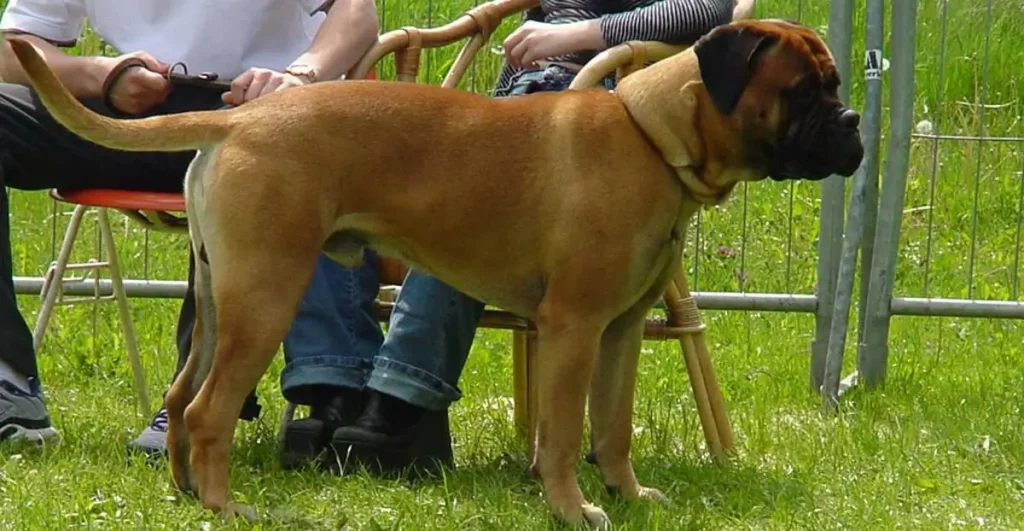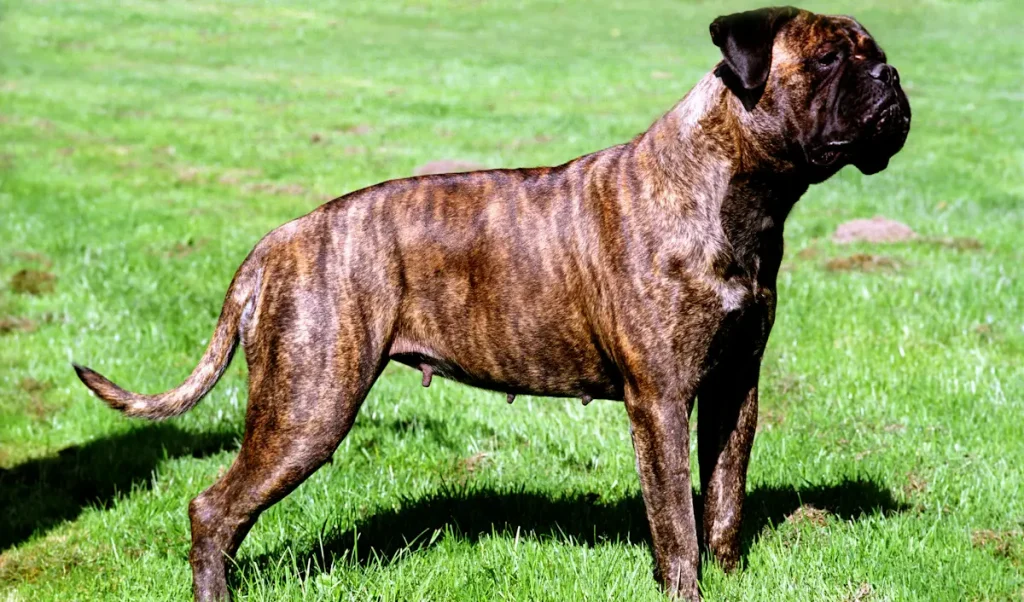Imagine standing beside a Bullmastiff, its formidable presence a blend of power and tranquility, a silent testament to the breed’s renowned guardian traits. As you consider bringing such a loyal companion into your life, it’s crucial to understand the characteristics that define this majestic breed.
Bullmastiffs possess unique strength, intelligence, and a surprisingly gentle disposition, making them exceptional protectors and family pets. Their temperament is one of controlled power; they’re calm but always alert, affectionate with family yet wary of strangers.
You might wonder how such a powerful dog interacts within a family setting or what it takes to ensure they become well-behaved household members. Uncover the layers of this gentle giant’s personality, learn about their needs, and see how their loyalty weaves them seamlessly into the fabric of your daily life.
- Noise Level
- Energy
- Sociability
- Trainability
- Care
- Health
Overall
Summary
Bullmastiffs are moderately noisy dogs with moderate energy levels. They are sociable, moderately trainable, and require moderate care. Overall, they tend to have good health.
Bullmastiff: Traits, Temperament, and Care Guide
Understanding the Bullmastiff’s traits and temperament is crucial for providing the right care and environment for this loyal and protective breed.
They’re gentle and affectionate family pets, exhibiting guardian traits that necessitate early socialization and positive reinforcement training.
As a Bullmastiff owner, you’ll manage their moderate exercise needs but be mindful of their tendency for health issues like hip dysplasia and bloat.
Exploring the Characteristics
While exploring the characteristics of the Bullmastiff, it’s essential to note their impressive stature. They typically weigh 110-130 lbs and stand about 25 inches at the withers. They are marked by a broad, wrinkled head and a short, square muzzle.
| Trait | Description | Relevance to You |
|---|---|---|
| Size | Large breed, imposing presence | Ensures a formidable guardian |
| Temperament | Protective nature, loyal companion | Provides steadfast loyalty |
| Energy Level | Low to moderate, suitable for family life | Aligns with your lifestyle |
| Origin | Originally bred by English gamekeepers | Heritage of reliability |
| Prey Drive | High prey drive, requires supervision around animals | Demands responsible ownership |
Bullmastiff: A Comprehensive Profile and Guide
You’re about to gain a thorough understanding of the Bullmastiff, a breed that combines strength with a calm demeanor.
This guide will provide detailed insights into their physical attributes, such as their distinctive broad head and short muzzle, and the exercise requirements that keep them healthy and content.
Recognizing their origins as guard dogs in England, you’ll learn how their temperament and lifespan reflect their breeding history.
Everything You Need to Know About
Diving into Bullmastiffs, you’ll discover a breed that combines strength, vigilance, and a warm temperament to form the ultimate family guardian.
- Originated in England, cherished by gamekeepers for guardian traits.
- Exhibits a calm demeanor, devoted to family members.
- Average life expectancy: 8-10 years, Prone To Health issues.
- Requires supervision with children, minimal grooming needed.
Discovering the Temperament of Bullmastiff
How does the temperament of a Bullmastiff reflect its role as both a guardian and a gentle family companion?
These gentle giants exhibit a laid-back attitude alongside guardian traits, a legacy of their origin as gamekeepers’ night dogs. With a loving family, Bullmastiffs are affectionate and loyal, yet their independent thinking can make training a challenge.
Socialization is key, as their protective nature may manifest in suspicion toward strangers.

Bullmastiff: Is It a Good Fit for Families?
You may wonder if a Bullmastiff is compatible with your family and children. These dogs exhibit a balance of gentleness and protectiveness, requiring early socialization to foster their acceptance of visitors and prevent overly guarded behavior.
Their low grooming needs and minimal shedding make the Bullmastiff a practical choice for busy households seeking a loyal pet.
Assessing Bullmastiff’s Compatibility with Families and Kids
When considering a Bullmastiff as a pet, it’s important to note its gentle nature and affection for family members. These qualities can make it excellent companions for households with children.
Gentle giants, known to be good with kids, fostering a sense of belonging.
Protective nature ensures they’re vigilant family dogs, establishing a strong bond.
Energy levels suit family life, though their size requires supervision.
Patient with children, but early socialization is key to maintain their composure.
Bullmastiff Adjustability Quirks
Understanding bullmastiffs’ adjustability quirks is essential. Their independent nature often makes training more complex and necessitates early socialization to temper their innate guardian instincts.
Their short coat means they’re less suited for hot or humid climates. They need lots of training for mental stimulation and to prevent weight gain.
It’s not a good idea to leave them alone, as their activity level and size require supervision.
Bullmastiff Obedience Essentials
To ensure your Bullmastiff’s compliance, you must prioritize early socialization and persistent training regimens. Given their propensity for independent thought, Bullmastiffs require training strategies that leverage positive reinforcement and frequent repetition to reinforce desired behaviors.
It’s paramount to supervise interactions with children and to provide a secure, fenced environment for exercise to safeguard both the dog’s and the public’s well-being.
Effective Training Strategies
Initiating training early with your Bullmastiff, and setting clear, consistent boundaries, lays the foundation for a well-behaved and obedient companion.
| Strategy | Benefit | Implementation |
|---|---|---|
| Positive Reinforcement | Enforces good manners. | Reward desired behaviors. |
| Repetition | Ensures commands stick with smart dogs. | Practice daily. |
| Socialization | Reduces suspicion, promotes friendliness. | Attend puppy kindergarten. |
| Consistent Routine | Establishes trust and structure. | Make sure to spend time playing and training. |
Exercise and Grooming Needs
Bullmastiffs’ exercise needs are moderate, but essential for their wellbeing. They require daily walks and playtime to maintain their health and contentment. Your Bullmastiff won’t require much exercise, yet it’s vital for their physical and mental health.
As for grooming needs, Bullmastiffs are easy to groom. Their short coats are low-maintenance. This low-shedding breed benefits from regular brushing to remove dead hair and keep their coat healthy.

Health Considerations
As you consider a Bullmastiff as your companion, be mindful of their health needs and predispositions. These dogs are susceptible to conditions such as bloat, heart diseases, and joint dysplasia, necessitating vigilant care and routine health screenings.
Common Health Issues and Lifespan
When considering a Bullmastiff as your companion, it’s important to be aware that they typically enjoy a lifespan of 7-9 years and are predisposed to certain health conditions, including hip dysplasia, bloat, and cancer.
Regular veterinary check-ups are crucial for early detection of health issues.
Exercise, such as regular walks, is key to maintaining a healthy weight and preventing joint problems common in this breed.
Is Bullmastiffs the Right Pet for You?
Determining whether a Bullmastiff matches your lifestyle requires assessing your experience with dog training and the age dynamics of your household.
As pet parents, you’ll find their temperament and guardian traits thrive in families with older children.
A Bullmastiff’s need for a fenced area and socialization aligns with a desire for peace of mind when introducing them to new people, ensuring a harmonious fit with your family.
Alternatives for Bullmastiff: Powerful and Protective Large Guardian Breeds
For those who love the Bullmastiff’s power and protective instincts, these large guardian breeds offer a similar combination of strength and assurance.
| Similar Dogs | Short Description |
|---|---|
| Rottweiler | Robust breed, great for protection, known for its loyalty. |
| Mastiff | Known for its large size and gentle nature, great for protection and family life. |
| Cane Corso | Muscular and ancient Italian breed, known for its protective instincts. |
| Dogue de Bordeaux | A large French breed, known for its protective nature and loyalty. |
| Boerboel | A South African breed, known for its strength and confidence as a guardian. |
Conclusion
The Bullmastiff is a guardian with a heart of gold, blending strength with gentle devotion. As you embark on a journey with this noble companion, remember that regular check-ups and exercise are the keystones to their wellbeing.
They’ll thrive with your guidance and affection. Whether you’re seeking a loyal friend or a steadfast protector, this breed might just be your match, wrapped in a majestic package.
Choose wisely—this gentle giant’s life is in your caring hands.
Frequently Asked Questions
How Protective Are Bullmastiffs?
Bullmastiffs have an intimidating presence and strong protective instincts, making them outstanding family guardians. Their breed reputation for loyalty and guard dog skills is well-earned, but training’s vital to managing territorial behavior.
What Is the Temperament of a Bullmastiff?
As gentle giants, Bullmastiffs exude a quiet demeanor infused with family loyalty. Their intelligence demands consistent training and socialization. Despite their affectionate behavior, they need regular exercise to maintain a balanced temperament.
What Is the Attitude of a Bullmastiff?
Bullmastiffs exhibit a quiet demeanor, yet their stubborn streak can pose training challenges. They’re gentle giants, showing affectionate behavior and a playful nature. Family loyalty is prioritized. Remember, socialization’s importance can’t be overstated.
Do Bullmastiffs Turn on Their Owners?
You’re seeking assurance about owner safety with Bullmastiffs. Aggression triggers are rare; proper training and socialization impact behavior significantly. Loyalty evaluation reveals a misconception clarification: they’re protective, not aggressive if no warning signs are ignored.
